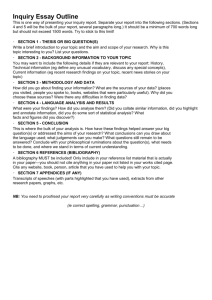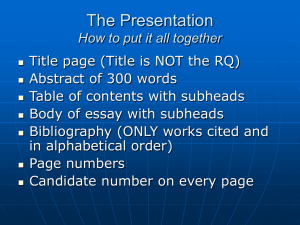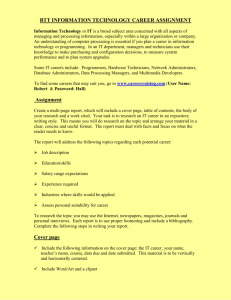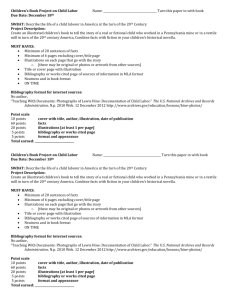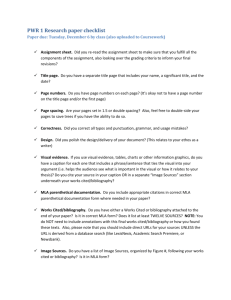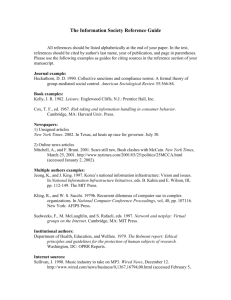Referencing using the Harvard author-date system
advertisement
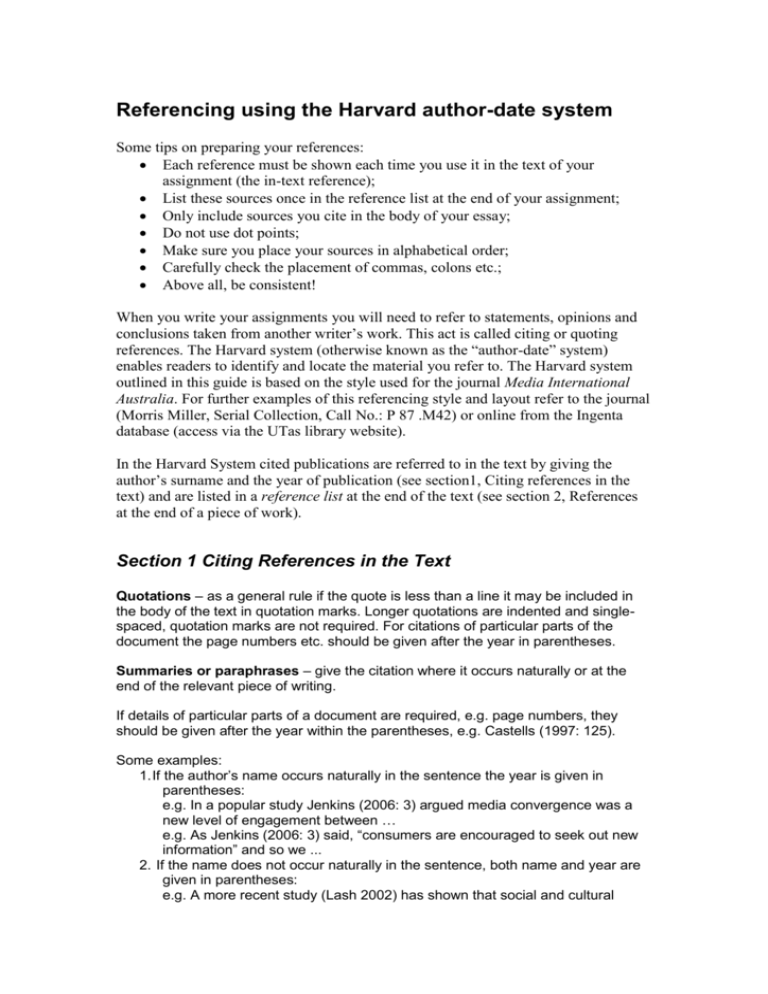
Referencing using the Harvard author-date system Some tips on preparing your references: Each reference must be shown each time you use it in the text of your assignment (the in-text reference); List these sources once in the reference list at the end of your assignment; Only include sources you cite in the body of your essay; Do not use dot points; Make sure you place your sources in alphabetical order; Carefully check the placement of commas, colons etc.; Above all, be consistent! When you write your assignments you will need to refer to statements, opinions and conclusions taken from another writer’s work. This act is called citing or quoting references. The Harvard system (otherwise known as the “author-date” system) enables readers to identify and locate the material you refer to. The Harvard system outlined in this guide is based on the style used for the journal Media International Australia. For further examples of this referencing style and layout refer to the journal (Morris Miller, Serial Collection, Call No.: P 87 .M42) or online from the Ingenta database (access via the UTas library website). In the Harvard System cited publications are referred to in the text by giving the author’s surname and the year of publication (see section1, Citing references in the text) and are listed in a reference list at the end of the text (see section 2, References at the end of a piece of work). Section 1 Citing References in the Text Quotations – as a general rule if the quote is less than a line it may be included in the body of the text in quotation marks. Longer quotations are indented and singlespaced, quotation marks are not required. For citations of particular parts of the document the page numbers etc. should be given after the year in parentheses. Summaries or paraphrases – give the citation where it occurs naturally or at the end of the relevant piece of writing. If details of particular parts of a document are required, e.g. page numbers, they should be given after the year within the parentheses, e.g. Castells (1997: 125). Some examples: 1. If the author’s name occurs naturally in the sentence the year is given in parentheses: e.g. In a popular study Jenkins (2006: 3) argued media convergence was a new level of engagement between … e.g. As Jenkins (2006: 3) said, “consumers are encouraged to seek out new information” and so we ... 2. If the name does not occur naturally in the sentence, both name and year are given in parentheses: e.g. A more recent study (Lash 2002) has shown that social and cultural theory increasingly become media theory. e.g. Media theory arises where media pervades social and cultural life (Lash 2002). 3. When an author has published more than one cited document in the same year, these are distinguished by adding lower case letters (a,b,c, etc.) after the year and within the parentheses: e.g. Flichy (2005a) has argued that … 4. If there are two authors the surnames of both should be given: e.g. Lash and Urry (1989) argue that commodities and production processes … e.g. … the information-based nature of commodities and production (Lash and Ury 1989). 5. When more than one study is cited, arrange the references in alphabetical order and use semicolons to separate them: e.g. A number of researchers (Bennett, 1967; Dent, 1969; Groom, 1969) have advanced this argument; however, the opposite view also has considerable support (Cummings, 1985; Norquest, 1984). 6. If there are more than two authors the surname of the first author only should be given, followed by et al.: e.g. New media has helped broaden democracy (Tsagarousianou et al. 1998) e.g. Audiences of a series can be categorised along the lines given by Reeves et al. (1996) … (A full listing of names should appear in the bibliography.) 7. If the work is anonymous then “Anon” should be used: e.g. In a recent article (Anon 1998) it was stated that... 8. If it is a reference to a newspaper article with no author the name of the paper can be used in place of “Anon”: e.g. More people than ever seem to be playing computer games (The Age 2007) (You should use the same style in the bibliography.) 9. If you refer to a source directly quoted in another source you cite both in the text: e.g. A study by Smith (1960 cited Jones 1994) showed that... (You should list only the work you have read, i.e. Jones, in the bibliography.) 10. If you refer to a contributor in a source (e.g. chapters in books, articles in journals, papers in conference proceeding, etc.) you cite just the contributor: e.g. Software development has been given as the cornerstone in this industry (Bantz 1995). See Section 2 below for an explanation of how to list contributions (chapters in books, articles in journals) in the bibliography. 11. If you refer to a person who has not produced a work, or contributed to one, but who is quoted in someone else’s work it is suggested that you should mention the person’s name and you must cite the source author: e.g. Richard Hammond stressed the part psychology plays in advertising in an interview with Marshall (1999). e.g. “Advertising will always play on peoples’ desires”, Richard Hammond said in a recent article (Marshall 1999: 67). (You should list the work that has been published, i.e. Marshall, in the bibliography.) Section 2 References at the end of a piece of work The Reference list in the Harvard Author-Date system: is titled ‘References’ is arranged alphabetically by author’s family name is a single list—books, journal articles and electronic sources are listed together and not arranged in separate lists includes the full details of your in-text references (author, date, title, publishing details) is not a bibliography—you do not need to produce a bibliography for your assignments unless specifically asked to do so by your lecturer. A bibliography lists everything you may have read, while a reference list is limited to the in-text references in your assignment Book Author Year, Title, Publisher, City. For example: Ang, Ian 1996, Living Room Wars: Rethinking Media Audiences for a Postmodern World, Routledge, London. Article in book Note: Use initial for the editors first name with full surname. Author Year, 'Title', in Editor (ed) or (eds), Book Title, Edition edn, Publisher, City, p. or pp. Pages. For example: Ross, Andrew 2000, 'Hacking Away at the Counter-Culture', in D. Bell (ed), The Cybercultures Reader, Routledge, London, pp. 254-267. Article in book (with multiple authors and editors) For example: Reeves, Jimmie L., Rodgers, Mark C. and Epstein, Michael 1996, ‘Rewriting Popularity: The Cult Files’, in D. Lavery, A. Hague and M. Cartwright (eds), Deny All Knowledge: Reading the X-Files, Faber and Faber, London, pp. 22–35. Chapter in book (where the chapter and book are written by the same person) Author Year, 'Title', Book Title, Edition, Publisher, City, p. or pp. Pages. For example: Morley, David 2006, 'Magical Technologies: The New, the Shiny and the Symbolic', Media, Modernity and Technology: The Geography of the New, Routledge, London, pp. 293-309. Journal article Author Year, 'Title', Journal, vol. , no. Issue, p. or pp. Pages. For example: Iwabuchi, Koichi 1995, 'Return to Asia? Japan in the Global Audiovisual Market', Media International Australia, no. 77, pp. 94-106. Newspaper article Author (or Newspaper) Year, Title, Newspaper, Date, Pages. For example: Abelson, Jenn 2007, 'Making Toys for the Bigger Kids', Boston Globe, 17 Dec, p. 1 New York Times 1992, ‘Picking up the bills’, New York Times, 4 June, p. 28. Magazine articles Author (or Magazine) Year, Title, Magazine, Date, Volume, Issue, Pages. For example: Treloar, Dorris 1999, 'Grains of Sense’, Australian Gourmet Traveller, November, No. 64, pp. 29-30. Electronic publication Author Year of publication (where known), Title, publisher, date accessed from the internet, the internet address (URL) is enclosed in < and >, with the full address. Note, these details are sourced from: Commonwealth of Australia 2002, Style manual for authors, editors and printers, 6th edn, rev. Snooks & Co., John Wiley & Sons Australia, Brisbane. For example: University of Tasmania Library 2003, Management subject guide, University of Tasmania Library, viewed 10 September 2003, <http://www.utas.edu.au/library/info/subj/management.html>. ABC News Online 2007, Budget spending prompts rates warning, ABC, viewed 9th May 2007, <http://www.abc.net.au/news/newsitems/200705/s1918156.htm>. Video, film or broadcast Title, Year. (For films the preferred date is the year of release in the country of production.) Type of audio-visual (e.g. Film, Video, DVD, TV, Radio). Author/Director. (Optional but preferred) Production details – place: organisation. e.g. Macbeth 1948, Film, Directed by Orson Welles. Republic Pictures, USA. e.g. Outfoxed: Rupert Murdoch's War on Journalism 2004, Film, Directed by Robert Greenwald, The Disinformation Company, USA. Television program: Title, Year, Type, transmitting organisation and channel, and the full date and time of transmission. e.g. Sleek Geeks 2008, TV, ABC, Jan 17, 2000 hrs. e.g. Southern Cross Nightly News 2008. TV, Southern Cross Broadcasting, Jan 27, 1800 hrs. Where known, the number and title of the episode should normally be given, as well as the series title. e.g. Yes, Prime Minister Episode 1: The Ministerial Broadcast, 1986, TV, ABC, Jan 16. Contributions: individual items within a programme should be cited as contributors. e.g. Rudd, Kevin 2008, Interview, in The 7.30 Report, TV, ABC, Feb 12, 1935 hrs.
